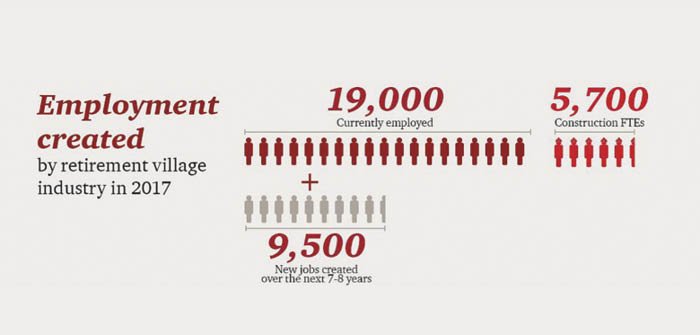PwC research commissioned by the Retirement Villages Association (RVA) found that new villages made a significant contribution to local economies around New Zealand. The report found that each new 250 unit village directly supported some 303 full time equivalent (FTE) staff and contributes approximately $21.4 million in design, construction and fittings to GDP.
Nationally, day-to-day operations in the retirement village industry contributed around $1.1 billion to the country’s GDP in 2017, accounting for roughly 0.4 percent of the total – similar to the value from the motor vehicle retailing industry in 2016, the report said.
“The impact of this development in the Bay of Plenty region is profound,” said RVA executive director John Collyns, who recently visited Tauranga.
There are 12 existing villages in the Bay with around 870 units either at the design, consenting or construction stage, with a further six brand-new villages with 540 villas or apartments on the drawing-board. While these are spread around the region from Tauranga to Whakatane, collectively they amount to 1408 units or 8.3 percent of New Zealand’s total retirement village development pipeline (16,880 units across 163 villages), according to the Jones Lang LaSalle NZ Retirement Village database, April 2018.
Applying the PwC yardstick, the 1400 units could create 1700 construction full-time jobs and generate $117 million for the Bay’s economy, said the PwC report.
“The gift doesn’t stop giving then either, with a longer-term potential of 800 full-time roles in managers, chefs, caregivers, activities coordinators, cleaners, maintenance staff, gardeners, and clinicians,” said Collyns.
The RVA says the villages are also efficient land users too. With housing land in short supply, the 1400 retirement village units will occupy around 38.22 ha, compared with a conventional housing development that will take up around 84 ha of valuable real estate (i.e. 273 m2 per unit for a RV development v. with 600 m2 for a conventional development), according to PwC.
“There is a clear demand from older people for retirement villages because they meet a number of important needs,” said Collyns.
These include providing purpose-built age-appropriate warm, comfortable and secure homes. Selling the family home releases tens of thousands of dollars in pent-up equity and puts a family home back on the market, while adding to an older person’s life savings.
Retirement villages provide a community of like-minded people and new friends that help keep loneliness at bay, says the RVA.
“There is no doubt that the boom in retirement village development not only adds significantly to the local economy via investment and employment, but it also has valuable social benefits,” said Collyns. “We look forward to continuing to develop villages in the Bay of Plenty region.”










